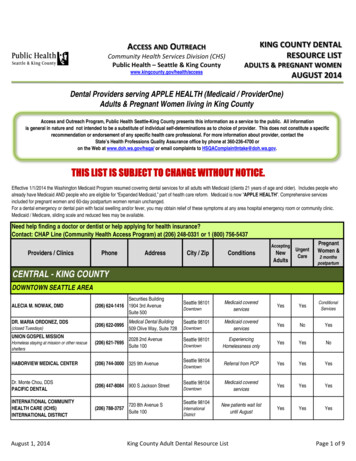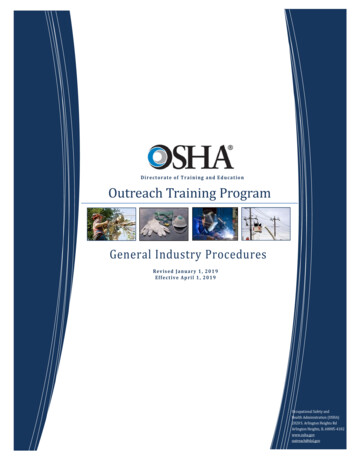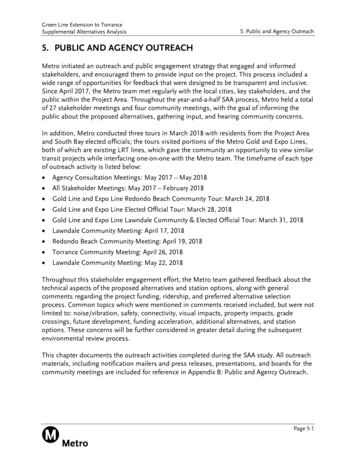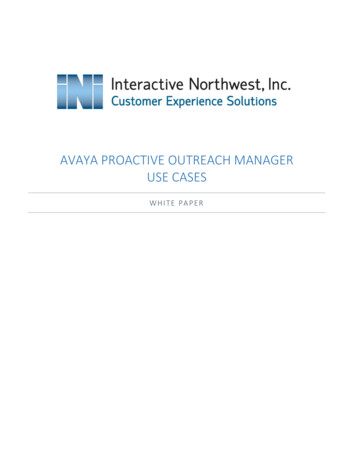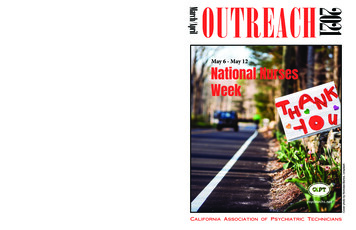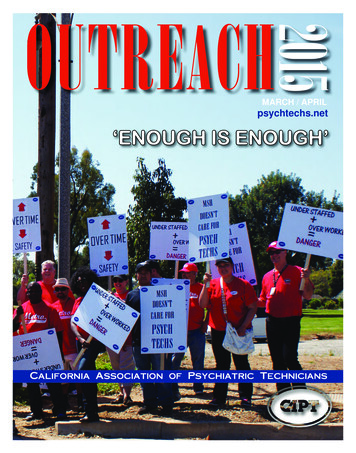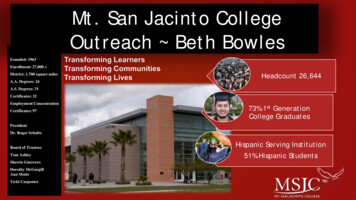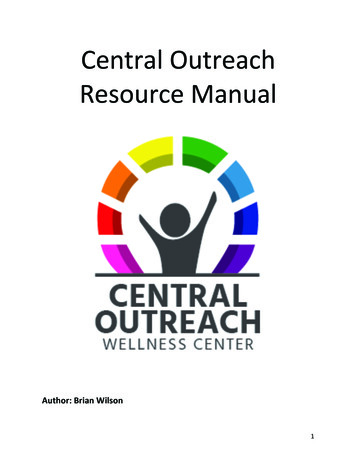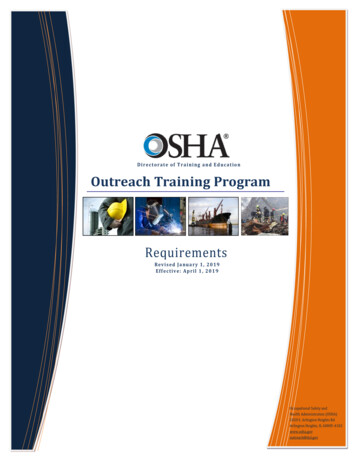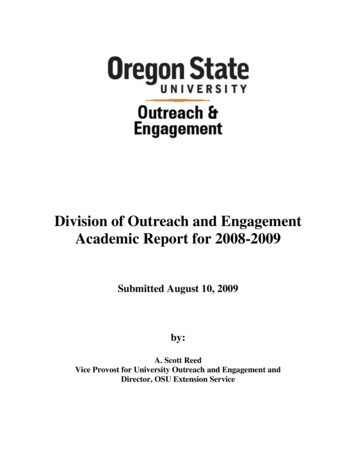
Transcription
Division of Outreach and EngagementAcademic Report for 2008-2009Submitted August 10, 2009by:A. Scott ReedVice Provost for University Outreach and Engagement andDirector, OSU Extension Service
2008-2009 HighlightsThis Academic Report integrates activities, accomplishments and perspectives ofUniversity Outreach and Engagement outside of items expected to be reported byindividual OSU colleges. It includes principal features of the OSU Extension Serviceand OSU Extended campus (Ecampus). For a complete picture of the essentialelements of University-wide outreach and engagement, the appropriate section(s) ofeach academic report should be consulted.1. Programmatic Achievementsa. Student engagement and successEnrollment in online courses offered through OSU Extended Campushas grown substantially: approx. 20% increase over the prior year; in2008/2009 – between 2,300-3,200 individual students or learners per term.Student Credit Hours2007/2008 51,318 SCHApprox. 13% increase over the prior year2008/2009 comparison: 62,194 SCHOSU Summer SessionEnrollment in Summer Session coursesOregon residents4,036U.S. Non-Oregon963International365Total 2008/2009 unduplicated headcounts of on-site students enrolled was5,364.OSU Extension Learner ContactsOregonians engaged in some meaningful way withExtension education efforts: more than 2,340,000Extension Volunteers - OSU Extension involved 19,772 volunteers indelivering Extension programs throughout the state. These volunteerscontributed 990 thousand hours to Extension programs such as 4-H, MasterGardeners, Master Food Preservers, Master Woodland Managers and OregonFoods and Nutrition program. These volunteer hours are equivalent to 475FTE.Ecampus increased access for campus-based students in impactedcoursesApproximately 10% of campus-based students took at least one Ecampuscourse.2
Approximately 60% of students enrolled in Ecampus courses are alsoenrolled in OSU campus-based courses. These on-campus students choseEcampus courses primarily as a solution to help them get access to acourse that was unavailable on campus. Others prefer the flexibilityonline courses provide in their schedule.Students seeking degrees through Ecampus online programs continueto growStudents seeking degrees through Ecampus increased from 865 in 200708, to 1,102 in 2008-09 academic year.In 2006-07, 87 students graduated from OSU through programs offeredvia Ecampus. In 2007-08 131 students graduated.Distance students use Ecampus courses/programs to access OSU. Theycan’t get to Corvallis because of their career or family commitments.Through Ecampus they are able to become “OSU students” whilecontinuing with their life commitments.Approximately 70% of Ecampus students are women. Many of thesewomen are mothers and find online courses to be the way to juggle familycommitments and school at the same timeNew Courses DevelopedApproximately 130 new OSU Extended Campus online credit courses weredeveloped from the following colleges:CLA - 47CAS - 21COB - 5COS - 14FOR - 6COAS - 3HHS - 7CoEd - 29New Programs Developed12 new or revised OSU Extended Campus multi-course online creditprograms were developed:Business and Entrepreneurship MinorChemistry MinorPhD Ed-CounselingTeacher Leadership PhDTwo Year MATESOL LicensureEducation Double DegreePre-Law SeriesAdult Ed MastersPolitical Science3
SociologyFisheries and Wildlife BAAnnual Course Offerings— Extensive course offerings across 10 Colleges:2008-09 Courseofferings by CollegeAgricultural ScienceBusinessEducationForestryScienceLiberal ArtsCOASEngineeringInterdisciplinaryAcademic LearningHealth & HumanSciencesTotalsTotal number s Creditoffered 68810800267721750716225521375277862449643Exam Proctoring—To accommodate the growing number of proctoredexams, Ecampus continued to refine its Web-based application throughwhich students arrange for test proctoring when required by their instructor.This year Ecampus proctored nearly 9,000 individual exams for 5,400students in 250 online courses.Online Orientation— Ecampus continues to refine an online orientation fornew distance students. This year approximately 480 newly admitted, degreeseeking Ecampus students completed the online orientation prior to theirappointments with their program advisor. We are currently inconversations with OSU START (campus orientations) to re-purpose ouronline orientation for campus-based students who are not able to attendSTART in person.Student Services Support—Pre-admission contacts:4
o Individual student contacts, initiated by the student (emailor phone): 8/day (40/week; 160/mo.; 1,920/year)o Unofficial transfer evaluations: 2/day (10/week; 40/mo;480/year)o Community college transfer fairs attended: 24/yearo Employer-sponsored education fairs attended: 30/yearo Community college site visits: 20/yearDistance degree-seeking student supporto Ecampus provided administrative support to 1,102students enrolled in our distance degree programs.Student Evaluation of Teaching— Ecampus continued to offer the onlineversion of the SET. Response rate averaged 26% over the academic year,with winter term topping out with a 31% response rate. Averaged over theyear, 85% rated their course as a whole as good to excellent, while 82% ratedtheir instructor’s contribution as good to excellent.Financial Aid—OSU Extended Campus allocated 300,000 for eligibledegree-seeking Distance Education students and Summer Session students,through the Office of Financial Aid in fiscal year 08-09.Developmental Math (MTH 65/950)—OSU Extended Campus coordinatesOSU’s on-campus and online Developmental Math courses. These courseshad approximately 450 enrollments during 2008-09 and helped OSUstudents prepare for college level math.EXTENSION OUTREACH EDUCATION PROGRAM HIGHLIGHTSThese are examples. See college reports for more information.Wood Innovation Center Connects Research to Industry NeedsLast spring the Extension-led Oregon Wood Innovation Center (OWIC)worked with an Oregon company competing for a contract to export hemlocklumber to China. The Chinese company took the position that Oregon secondgrowth hemlock lumber was not as good as the old growth hemlock availablefrom a lumber export firm in Canada. OWIC was able to quickly compile andpresent a detailed research-based report comparing old-growth and secondgrowth hemlock that convinced the Chinese to award their contract to theOregon company.Outcome: The Portland company is now selling 200,000/month of Oregongrown second-growth hemlock, milled in Oregon, to China, due in large partto Extension’s linkage to OSU research and ability to rapidly respond topractical information needs of Oregon entrepreneurs.Pesticide Safety Faculty Inform Development of Policy5
Before 2009 Oregon was one of only 14 states not having pest managementregulations for public schools. In response, Extension faculty Paul Jepson andTim Stock helped guide the development of Senate Bill 637, the “PestManagement in Schools” act. Jepson and Stock work in OSU’s pesticide safetyeducation program.Outcome: Passed and signed into law in May 2009, Senate Bill 637 identifiesExtension to develop model integrated pest management plans for use inschools. Jepson and Stock also worked to secure grants from EPA and USDAto conduct pest management training in Oregon school districts.Extension Delivers Hunger Education to healthcare workersOregon has one of the leading hunger rates in the nation. Poorly nourishedchildren are at particularly high risk of suffering from health problems andrelated emotional and psychological issues.Extension Nutrition Educator, Anne Hoisington, headquartered inside theOregon Food Bank in Portland, developed the Childhood Hunger Initiative tocombat this problem. She, along with several partner health-care agenciesand organizations have trained hundreds of health care workers to recognizesigns of hunger and learn intervention strategies that are effective in helpingchildren and families at-risk for hunger.Outcome: Hoisington is expanding this educational program via creation of anew, five-unit online course on hunger intervention strategies, availablethrough Ecampus. Since it became available last October almost 300 nurses,physicians, dietitians and other health-care practitioners have taken thecourse.Extension 4-H Youth Development Program ImpactCurrently the OSU Extension 4-H Youth Development program enrolls150,000, or more than 1 in 5 youth in Oregon’s K-12 population. The OSUExtension 4-H youth development program emphasizes personal growththrough positive leadership, citizenship and life skills experiences.Outcome: As compared with youth in other out-of-school programs, 4-Hersare: 3.5 times more likely to volunteer in their communities 1.6 times more likely to expect to go to collegeAn example of program impact: In partnership with Intel, a technology-based4-H project called “Tech Wizards” focuses on Latino youth. Participants inthis Washington County 4-H club are raising their grade point averages,staying in school, and planning on going to college. Graduation rates for clubmembers are 95 percent; well over the graduation rate of 71 percent for thegeneral Latino student population in Oregon.Extension Small Farms Program OnlineExtension’s small farms program is broadening outreach to Oregon’s growingsmall farm population through expanding use of technology.6
Small farms—defined as 50 aces or less in size and earning 50,000 or lessincome annually—generate millions of dollars in agricultural sales each yearand are leaders in supplying locally grown produce, via farm-direct sales, toOregon communities. Extension delivers education on small acreagemanagement, commercial small farms entrepreneurship and communityfood systems direct marketing.Outcome: In 2008 the Oregon Small Farms website received nearly 1 millionhits, a 68 percent increase over 2007. Also in 2008, the website received over83,000 visitor sessions (defined period of interaction between a viewer and aparticular website), an increase of 55 percent over 2007. See the website athttp://smallfarms.oregonstate.edu/Sea Grant Extension Raises Awareness of Invasive SpeciesExtension conducts extensive public education and training programsintended to raise awareness of invasive species and theeconomic/environmental damage they can cause in Oregon watersheds.Extension recently worked with Oregon Public Broadcasting (OPB), TheSalem Statesman Journal, and the Oregon Invasive Species Council to developone of the nation’s largest and most effective public campaigns (including a10-month Statesman Journal series) to help people understand and respondto invasive species in Oregon. An OPB documentary on this subject, “SilentInvasions,” won the Dupont-Columbia award (equivalent to a Pulitzer Prizefor documentaries).Outcome: Increased awareness has led to passage of five pieces of newlegislation in the 2009 Oregon legislative session on invasive speciesprevention.Extension Grow Your Own campaignExtension and the Extension and Experiment Station Communications Dept.(EESC) launched the “Grow Your Own” campaign in February 2009, inresponse to the recession and high unemployment that hit Oregon earlier inthe year. The campaign sought to deliver the publication and other Extensiongardening information to new gardeners before spring planting. This effortincluded:Distributing additional copies (more than 6,000) of the Extension GrowYour Own home gardening information publication.A series of news releases, sent to more than 230 media contacts, featuringgardening information and highlighting availability of this informationfrom Extension.Home gardening information was made easier to access via the Extensionwebsite.Since the campaign began, OSU Extension web sites, including NorthwestGardeners E-News and the Gardening Encyclopedia webpage, received nearly60,000 hits per month.7
b. Research and its impactSpecial Grants—Ecampus awarded 100,000 for ten grants supportingfaculty research and scholarship (e.g., publishing) in the area of distanceeducation, outreach, teaching and learning online, new teaching and learningtechnologies and other related areas.Extension Grants and ContractsExtension faculty magnified and expanded their work in 2008 through morethan 300 grants and contracts, bringing in an additional 23 million. This isan increase of 13.8 million over 2007.Extension Innovative GrantsExtension awarded over 234,000 for seven innovative Extension outreacheducation projects. These projects include: Partnership for Clean Air andHealth; Childhood Hunger in Oregon: Educating and Engaging the MedicalCommunity; Urban Horticulture Education, and others.Eduventures collaborative market research projects-- Ecampusparticipates as a member of a collaborative research group in the field of‘continuing and professional education.’ Through Eduventures we haveconducted numerous market research studies, needs assessments, andcompetitive analyses. Many of these projects have been solely for Ecampus,where others have been collaborative studies with approximately 100 othercontinuing education/distance education units around the country. Theresults of these research projects have helped guide us and our facultymembers in our selection of program development and funding. It also keepsus informed of current trends in our field.Summer Session Survey—OSU Summer Session surveyed 5,015Corvallis campus-based summer enrolled students, with a 30% responserate. Of those students responding, 95% reported satisfied, somewhatsatisfied or neutral about their satisfaction with their academic experienceduring summer session. Students also stated "top reasons for taking summersession courses" including: major degree requirements, to graduate on time,to complete courses quickly, to reduce in-course load and avoid schedulingconflicts within the academic year.Other noted responses included:Students prefer four, eight and three week sessions over the one, or 11week sessions;Students prefer morning and early afternoon classes, in comparison toevening times.8
Students primarily obtained information about Summer Session via theon-line schedule of classes, Summer Session E-newsletter,Advisors/Professors and print ads in the Barometerc. Outreach and engagementNEW PROGRAM HIGHLIGHTSThese programs are the first examples of Extension and Ecampus workingjointly to develop and deliver outreach education programs targeted to highpriority learning needs of Oregonians and others throughout the world.Lifelong Learning Program: “Mastery of Aging Well”Supported by a 300K US Dept. of Agriculture grant, this program providespractical, research-based solutions to many of the problems aging individuals,or care-givers of aging family members may encounter. The project hasdesigned five engaging, online programs to support individuals in masteringthe challenges that come with getting older. Ecampus and EESC are workingcollaboratively in the development of program materials that will be providedin three formats: 1-an informational series of self-paced modules made freelyavailable on an OSU-hosted website; 2- a live interactive, fee-based onlinecourse with instructor facilitation; 3- DVD presentation of the fee-based courseenhanced with supporting publications.Lifelong Learning Program: “Online Master Gardener”This is the first collaborative program from the new division of Outreach andEngagement. Ecampus worked with Extension to create an online version ofthe successful site-based master gardener program. Through the onlineversion we have successfully increased access to and participation in thisprogram. Students registered from throughout Oregon as well as 13 otherstates and Canada. Student reviews rated the program very positively and wecontinue to get requests to enroll in this new popular online program.The program was offered twice in 2008/09 with an enrollment of 129students.Faculty involvement with Ecampus courses—All Ecampus instructors areapproved by their academic departments. Below are the numbers ofinstructors teaching the 600 Ecampus courses.ProfessorAssociate ProfessorAssistant ProfessorSenior InstructorInstructorEmeritus AppointmentGTA/GA513126108911269
Participants-- Through our worldwide communication and Internetmarketing strategies Ecampus recruited students from across the countryand world to OSU online courses and programs. In 2008/09 Ecampusenrollments included students from every state as well as 40 foreigncountries.Portland Metro area—In order to better serve this major population center,OSU Extended Campus has co-located its Community College Coordinator inPortland with the OSU Foundation to enhance the OSU neighborhoodconcept, and to allow for greater outreach and recruitment of students in thegreater-metro community colleges and business communities.Summer Session Community Outreach ProjectsFree-Noon Concerts: every Wednesday from June – August, open to thepublic.University Theater presentations: August – September, open to thepublic.Partnership w/College of Education to offer four Teacher/CounselorEducator courses with 92 students participating on the PortlandCommunity College (Sylvania) campus and in Medford.Establishment of self-sustaining Summer Session programs in threegeographical areas within the state of Oregon (Portland Metro, Medfordand Oregon Coast).Collaboration with the Hatfield Marine Science Center (Newport) to offernine undergraduate, graduate credit courses and professional workshopswith 26 students participating on the Oregon coast.Extension Faculty involvement in outreach and engagementProfessorAssociate ProfessorAssistant ProfessorInstructorSenior Faculty Res. Asst.Faculty Res. Asst.6165476345EXTENSION INITIATIVES HIGHLIGHTSClimate Masters ProgramIssue: Global climate change and reduction of greenhouse gas emissions arehigh priority issues in Oregon, and throughout the U.S. This has createdgrowing need for community-level education programs that help citizenslearn what they can do to make a difference locally.The Climate Masters Program is a model for educating citizens about climatechange and engaging them in activities in their household and community to helpreduce their energy use and carbon footprint. The University of Oregon’s ClimateLeadership Initiative (CLI) developed and modeled the Climate Masters (CM)10
program after OSU Extension’s successful Master Gardener and Master Recyclerprograms. Climate Masters is a program in which individuals take 10-11 weeks ofclasses and then volunteer 30 hours to assist others in assessing and reducing theircarbon footprint.The program was developed and tested in Eugene. Sarah Mazze from the UOCLI contacted OSU Extension to expand delivery of the program across Oregon.Two workshops attended by about 20 Extension faculty were offered to introducethe program. Interest has been expressed by 14 counties. Several countiesexpressed interest in a youth program, which is now under development (JuniorClimate Stewards) and will be ready to pilot test this fall.The Climate Master program was offered by Extension in Corvallis lastwinter. There were 24 participants and 6 faculty involved. The volunteercomponent of the program is being managed by a CM program graduate. So farthe participants have engaged in 22 home energy consultations. Results of theEugene program indicate that participants reduced emissions by an average oftwo tons per person. Also, the program brought about changes in thinking,helping participants to add a “climate filter” to their decision making processes. Inaddition the program resulted in stronger community connections, cost savings,and environmental benefits.A number of Extension Offices and communities have expressed interest inoffering the Climate Master program. However, fiscal resources need to beacquired to support staffing for the program. This spring the Legislature passedand the
Exam Proctoring—To accommodate the growing number of proctored exams, Ecampus continued to refine its Web-based application through which students arrange for test proctoring when required by their instructor. This year Ecampus procto

